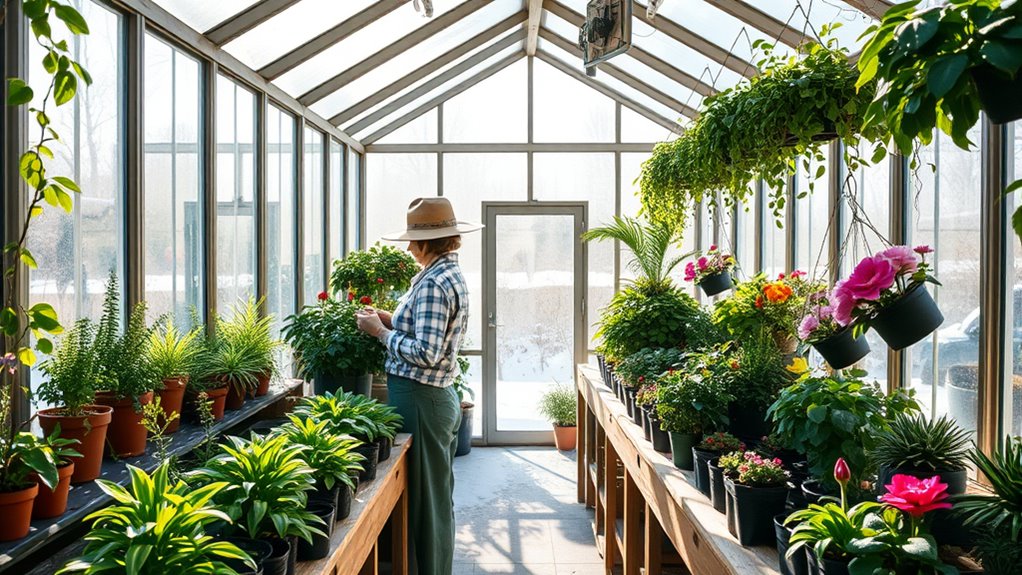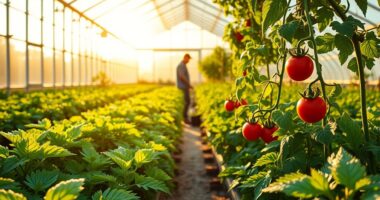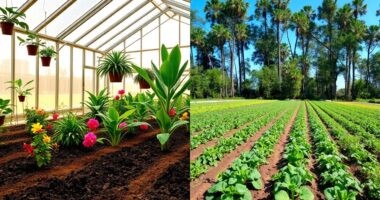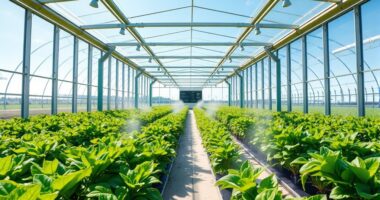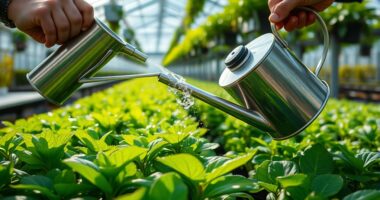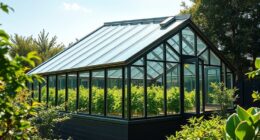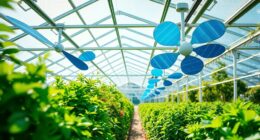You might think greenhouses are too expensive or less eco-friendly than traditional farming. In reality, they can save you money on water and chemicals long-term. They also promote sustainability through water recycling and lower carbon footprints. Plus, greenhouse produce can be just as nutritious, if not more so, than field-grown crops. You may also believe that greenhouses can’t operate year-round, but that’s a common misconception. Discover more about these myths and the real benefits of greenhouses.
Key Takeaways
- Initial costs of greenhouses may seem high, but long-term savings from reduced water and chemical use can offset these expenses.
- Greenhouses can be highly sustainable, utilizing water recirculation and solar energy to minimize environmental impact and carbon footprints.
- Controlled environments in greenhouses can enhance the nutritional value of produce, often matching or exceeding that of field-grown options.
- Greenhouses can grow plants year-round, with proper design and plant selection accommodating seasonal temperature variations.
- Not all greenhouses require high-tech solutions; various accessible designs cater to hobbyists and small-scale farmers.
Misconceptions About Cost
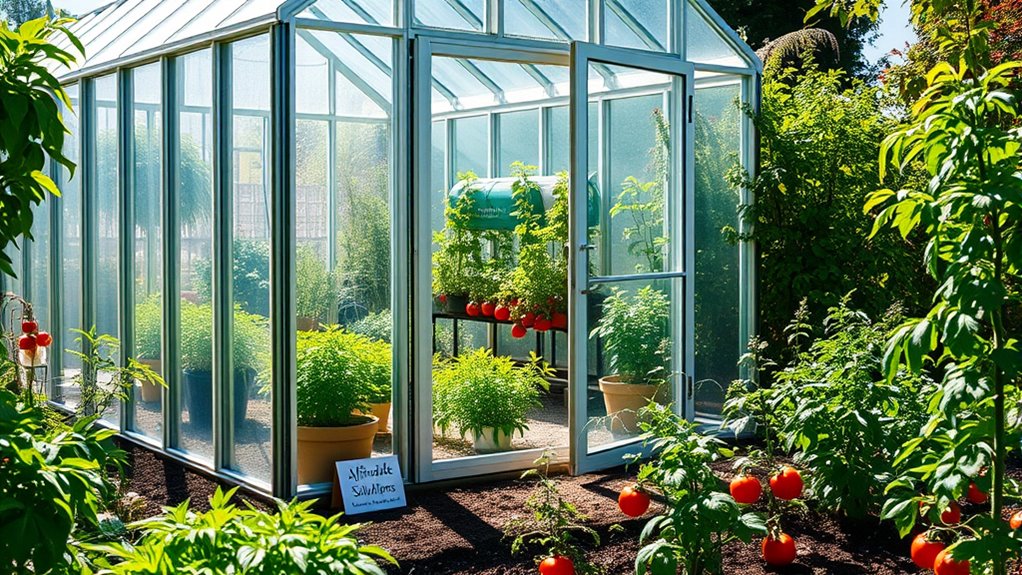
When evaluating greenhouse farming, many people mistakenly believe that the initial investment is prohibitively high compared to traditional farming methods. While it’s true that upfront costs can be significant, you need to weigh the long-term savings.
Greenhouses can lower water and chemical usage, leading to reduced ongoing expenses. Plus, you’ve got options—whether you choose a DIY approach for custom designs or a pre-fab kit for convenience, there’s a greenhouse to fit your budget. Additionally, many greenhouse designs prioritize space efficiency, which can further enhance your overall productivity.
Keep in mind that material quality affects both initial and long-term costs. Investing in energy-efficient systems can further minimize your operational expenses. Additionally, sustainable building practices can enhance your greenhouse’s efficiency and reduce costs over time.
Misconceptions About Sustainability
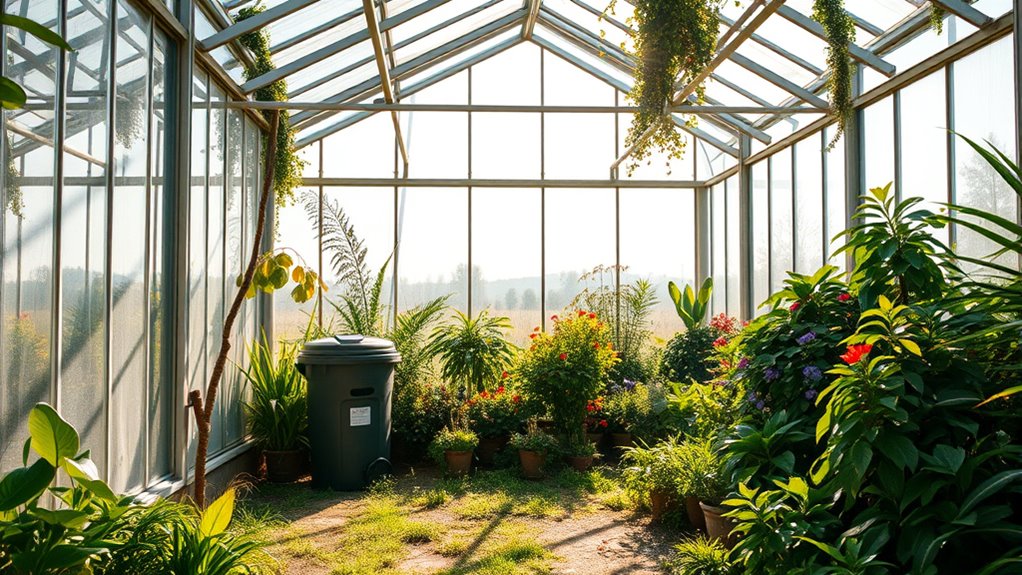
Many people underestimate the sustainability benefits of greenhouse farming, assuming it’s less eco-friendly than traditional methods.
In reality, greenhouses conserve water through recirculation systems, greatly reducing overall usage. They also lower carbon footprints by minimizing transportation, contributing to a more sustainable food supply chain. Additionally, solar energy solutions can be utilized to power greenhouse operations, further enhancing their sustainability. The controlled conditions in greenhouses can lead to increased crop yields, ensuring that more food can be produced with fewer resources. Moreover, music therapy can be integrated into greenhouse environments to create a calming atmosphere that enhances worker productivity and well-being. Greenhouses can also employ hydroponic systems to maximize space and resource efficiency, allowing for year-round production.
By extending growing seasons, greenhouses decrease reliance on imported produce, enhancing local food security. Additionally, they promote biodiversity, providing habitats for beneficial insects and plants, which fosters healthier ecosystems.
With controlled environments, greenhouses optimize resource use and can implement waste reduction strategies, minimizing pollution. Furthermore, renewable energy technologies can be integrated into greenhouse operations to further enhance their sustainability.
Ultimately, these practices make greenhouse farming not only environmentally friendly but also an essential component of sustainable agriculture.
Misconceptions About Nutritional Value
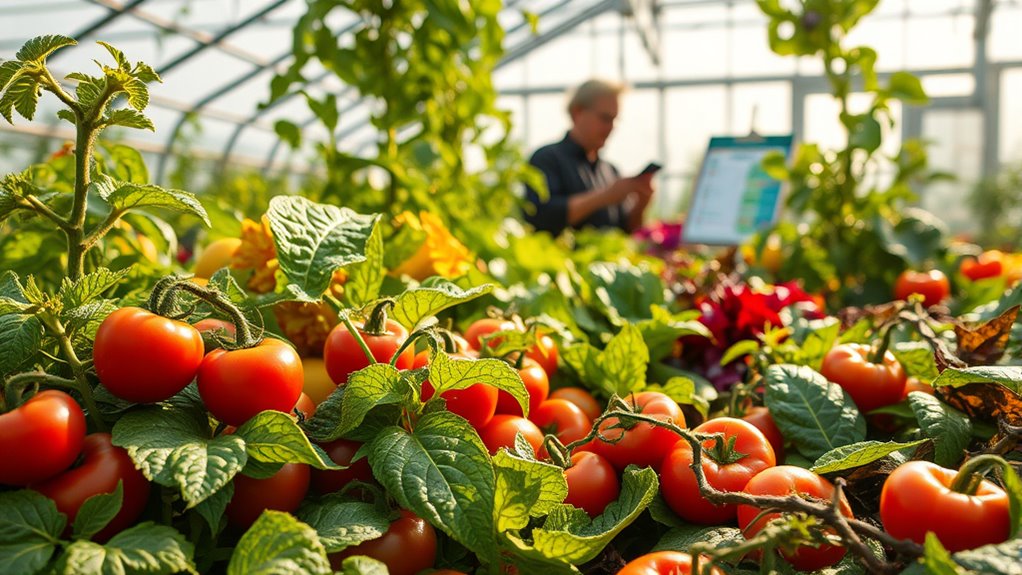
While some people believe greenhouse produce lacks the nutritional value of field-grown alternatives, this isn’t the full picture.
Greenhouses create controlled environments that can enhance nutritional profiles by maximizing factors like temperature and pest exposure. Techniques such as hydroponics promote better nutrient uptake, ensuring that plants receive essential minerals.
Greenhouses optimize growing conditions, enhancing nutritional profiles and ensuring plants absorb vital minerals through advanced techniques like hydroponics.
Remember, the nutritional value of fruits and vegetables primarily depends on soil quality, which can be precisely managed in greenhouses. Additionally, while some nutrients may degrade over time, minerals like calcium remain stable.
Hence, greenhouse produce can offer comparable, if not superior, nutrition to field-grown options. It’s vital to select the right cultivars for ideal nutrient content, regardless of the growing method.
Misconceptions About Seasonality
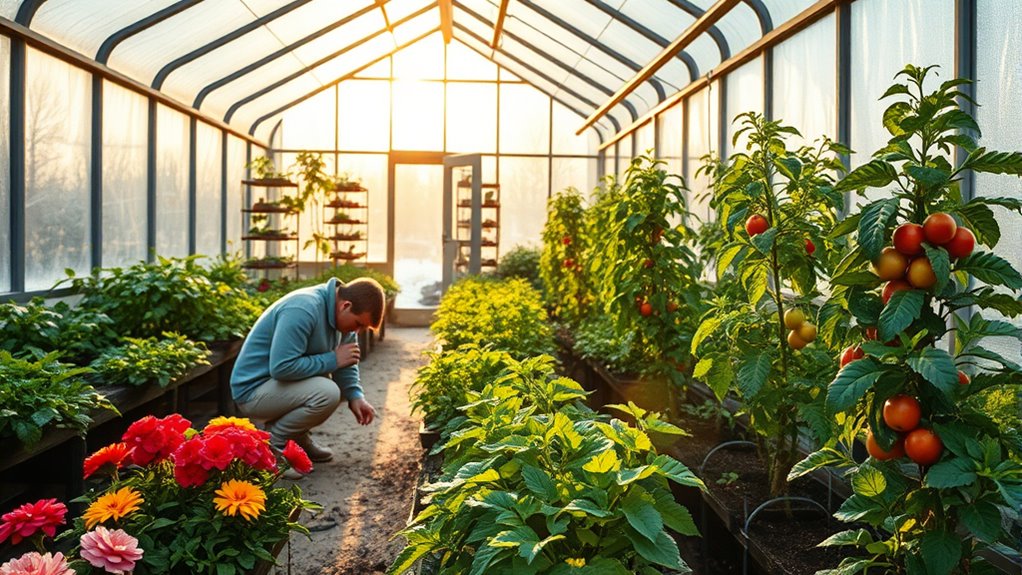
Seasonality in greenhouse cultivation is often misunderstood, leading to several misconceptions. Many believe that greenhouses can’t grow plants year-round, but with proper heating systems, you can cultivate plants in winter too.
It’s also a myth that soil temperature remains constant; it varies seasonally until about 20-24 feet deep. Additionally, climate batteries aren’t unlimited heat sources—they’re limited by slow heat movement through the soil, affecting their efficiency during seasonal changes.
You should also consider that regional heating and cooling needs differ, meaning not all areas require year-round heating or extensive cooling systems. Choosing the right plants for each season and maintaining ideal conditions are essential for successful greenhouse growth throughout the year.
Misconceptions About Technology and Design
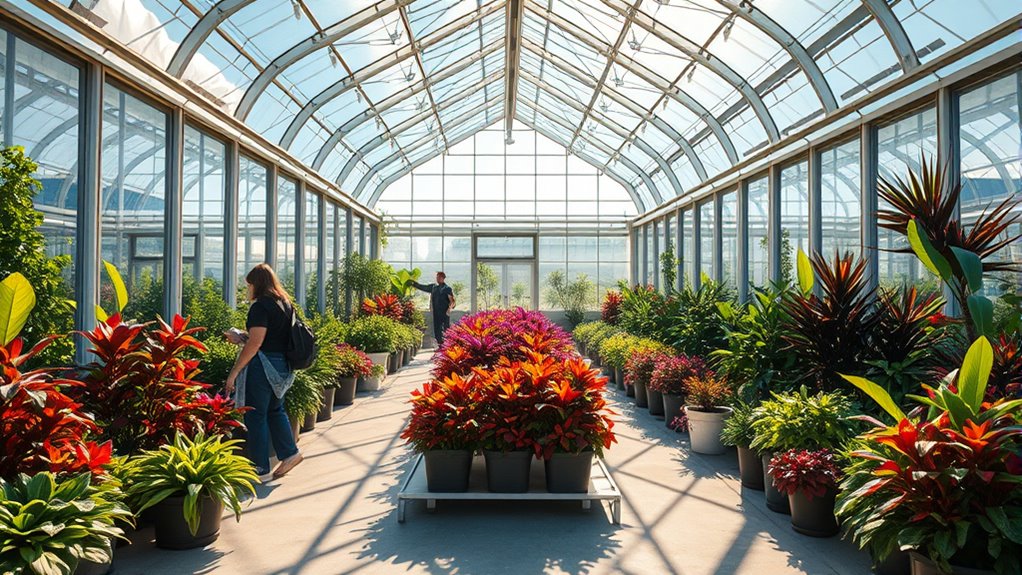
When considering greenhouse cultivation, it’s easy to fall for common misconceptions about technology and design that can mislead potential growers.
Many believe that a high-tech greenhouse is the only option, but there are various designs available, allowing you to choose one that fits your budget. Additionally, implementing automated insights can optimize your greenhouse’s operational efficiency. In fact, energy-efficient technology can also significantly reduce operational costs. Integrating solar panels into your greenhouse can further enhance sustainability and reduce reliance on external energy sources.
You might also think that greenhouse covers are purely for temperature regulation, but they serve multiple functions, such as pest protection and UV shielding.
Climate batteries don’t provide endless heating or cooling; they require careful design for efficiency.
Custom greenhouses can adapt to specific plant needs, and their modular designs make them accessible for hobbyists and small-scale farmers. Additionally, understanding investment strategies can help you allocate funds effectively for your greenhouse setup.
Frequently Asked Questions
Do Greenhouses Require a Lot of Maintenance?
Yes, greenhouses do require a fair amount of maintenance to guarantee ideal plant growth.
You’ll need to regularly check temperature and humidity levels, manage ventilation, and clean surfaces to prevent pests and diseases.
Additionally, inspecting the structural integrity and implementing shading solutions are crucial.
While it may seem demanding, consistent maintenance leads to healthier plants and can extend your growing season, making the effort worthwhile.
Can I Grow Tropical Plants in a Greenhouse?
Yes, you can definitely grow tropical plants in a greenhouse!
By utilizing the controlled environment of a greenhouse, you’ll create ideal conditions for these plants. You’ll maintain consistent temperatures and humidity levels, ensuring healthy growth.
With the right setup, you can cultivate vibrant orchids, Venus flytraps, and even tropical fruits year-round.
Just be sure to manage temperature, humidity, and ventilation effectively to keep your tropical oasis thriving!
What Materials Are Best for Greenhouse Construction?
Did you know that greenhouse structures can increase crop yields by up to 50%?
When constructing your greenhouse, consider materials carefully. Wood’s affordability and ease make it great for beginners, while aluminum offers durability and corrosion resistance.
For covering, polycarbonate is shatter-resistant and insulates well, while glass provides excellent light transmission.
Confirm your base is solid, with concrete or gravel for stability and drainage.
Choosing the right materials can enhance your gardening success!
Are Greenhouses Suitable for Urban Environments?
Yes, greenhouses are definitely suitable for urban environments! They maximize limited space, allowing you to grow fresh produce right in the city.
You can customize them for rooftops or vacant lots, making them adaptable to various settings. Plus, they provide year-round production, help improve air quality, and serve as community hubs.
How Do I Start a Greenhouse Business?
To start a greenhouse business, first conduct market research to identify local crop demand.
Next, create a thorough business plan outlining your financial goals and operational strategies.
Make sure you obtain the necessary permits and licenses to comply with local regulations.
Choose a suitable location with ample sunlight and utility access.
Finally, budget for your initial investment, including greenhouse structure, heating, cooling, and irrigation systems, to set yourself up for success.
Conclusion
In wrapping this up, it’s clear that many misconceptions about greenhouses can cloud your judgment. They’re not just for the wealthy or tech-savvy; anyone can benefit from their sustainable practices and year-round productivity. So, whether you think they’re just for fancy gardeners or that they compromise nutrition, it’s time to set the record straight. Embrace the future of gardening—after all, even the dinosaurs didn’t know they were going extinct until it was too late!
